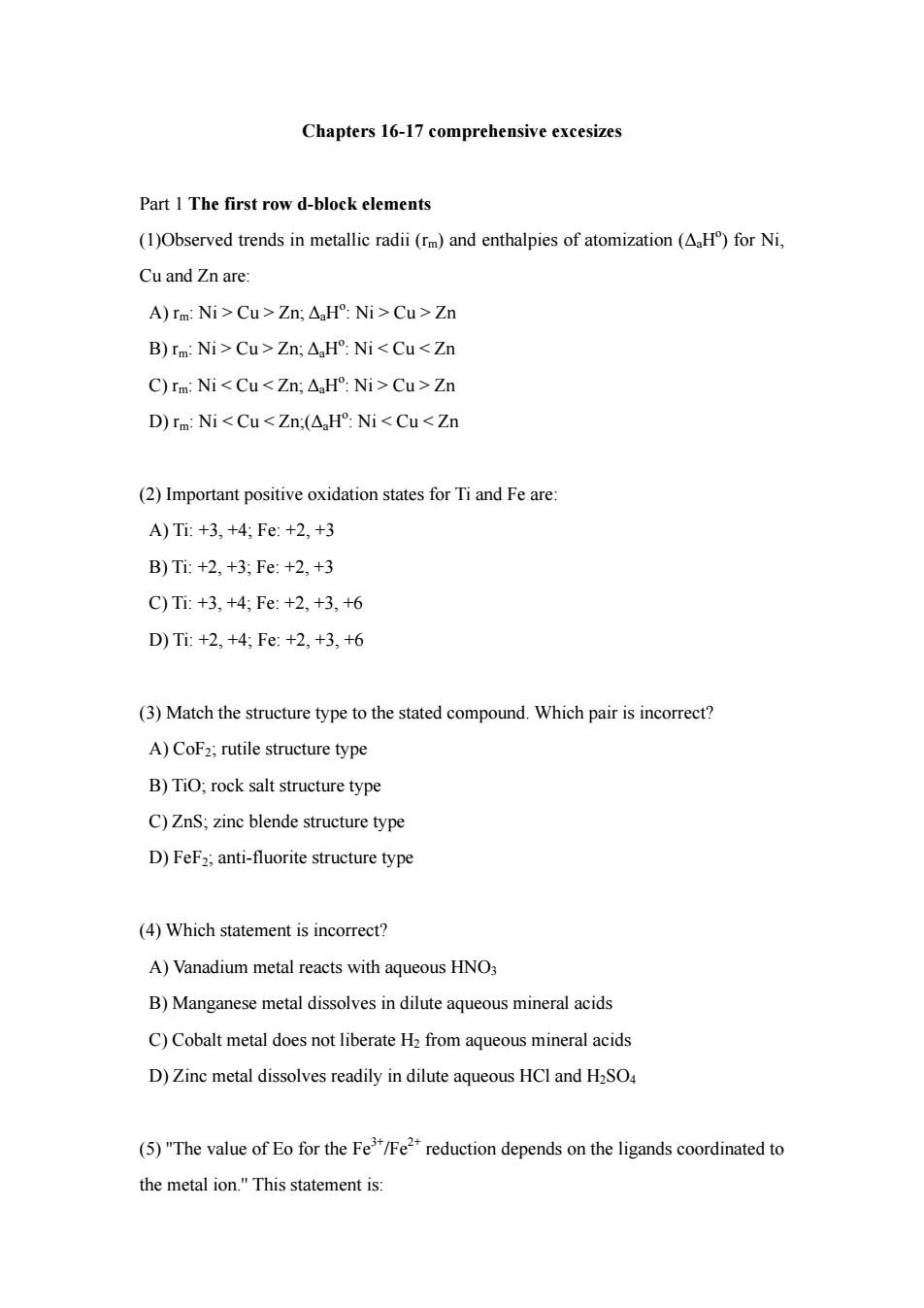
Chapters 16-17 comprehensive excesizes Part I The first row d-block elements (1)Observed trends in metallic radii (m)and enthalpies of atomization (H)for Ni Cu and Zn are: A)rm:Ni>Cu>Zn:A,H:Ni Cu>Zn B)rm:Ni>Cu>Zn;A.H:Ni <Cu<Zn C)rm:Ni<Cu<Zn;A.H:Ni>Cu>Zn D)rm:Ni<Cu<Zn(AH°:Ni<Cu<Zn (2)Important positive oxidation states for Ti and Fe are A)Ti:+3,+4Fe:+2,+3 B)Ti:+2,+3;Fe:+2,+3 C)Ti:+3,+4:Fe:+2,+3,+6 D)Ti+2,+4:Fe:+2,+3,+6 (3)Match the structure type to the stated compound.Which pair is incorrect? A)CoF;rutile structure type B)TiO;rock salt structure type C)ZnS;zinc blende structure type D)FeF2;anti-fluorite structure type (4)Which statement is incorrect? A)Vanadium metal reacts with aqueous HNO3 B)Manganese metal dissolves in dilute aqueous mineral acids C)Cobalt metal does not liberate H2 from aqueous mineral acids D)Zinc metal dissolves readily in dilute aqueous HCl and H2SO (5)"The value of Eo for the Fe"/Fe2reduction depends on the ligands coordinated to the metal ion."This statement is:
Chapters 16-17 comprehensive excesizes Part 1 The first row d-block elements (1)Observed trends in metallic radii (rm) and enthalpies of atomization (ΔaHo ) for Ni, Cu and Zn are: A) rm: Ni > Cu > Zn; ΔaHo : Ni > Cu > Zn B) rm: Ni > Cu > Zn; ΔaHo : Ni < Cu < Zn C) rm: Ni < Cu < Zn; ΔaHo : Ni > Cu > Zn D) rm: Ni < Cu < Zn;(ΔaHo : Ni < Cu < Zn (2) Important positive oxidation states for Ti and Fe are: A) Ti: +3, +4; Fe: +2, +3 B) Ti: +2, +3; Fe: +2, +3 C) Ti: +3, +4; Fe: +2, +3, +6 D) Ti: +2, +4; Fe: +2, +3, +6 (3) Match the structure type to the stated compound. Which pair is incorrect? A) CoF2; rutile structure type B) TiO; rock salt structure type C) ZnS; zinc blende structure type D) FeF2; anti-fluorite structure type (4) Which statement is incorrect? A) Vanadium metal reacts with aqueous HNO3 B) Manganese metal dissolves in dilute aqueous mineral acids C) Cobalt metal does not liberate H2 from aqueous mineral acids D) Zinc metal dissolves readily in dilute aqueous HCl and H2SO4 (5) ''The value of Eo for the Fe3+/Fe2+ reduction depends on the ligands coordinated to the metal ion.'' This statement is: 1
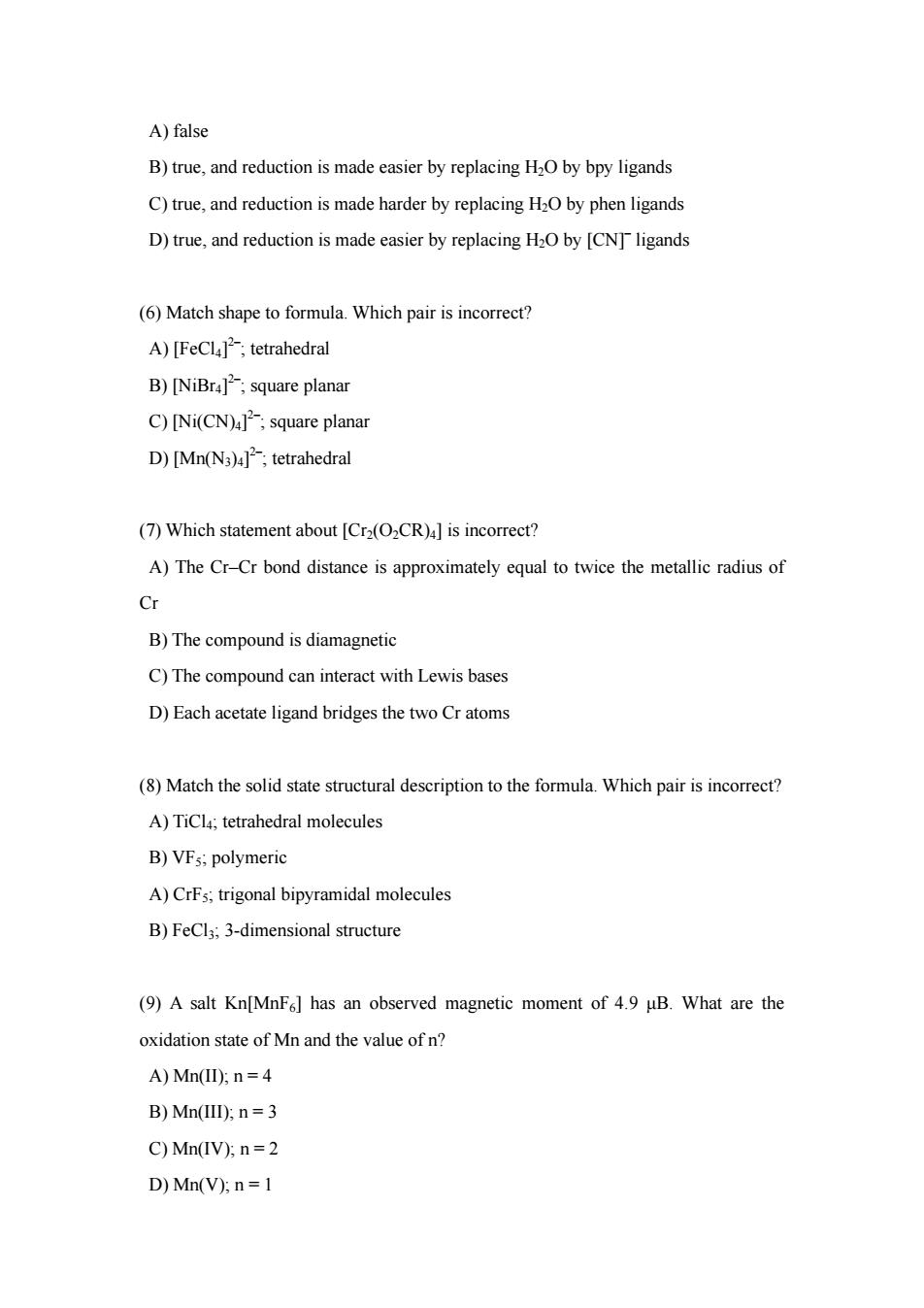
A)false B)true,and reduction is made easier by replacing HO by bpy ligands C)true,and reduction is made harder by replacing H2O by phen ligands D)true.and reduction is made easier by replacing H2O by [CN]ligands (6)Match shape to formula.Which pair is incorrect? A)[FeCl];tetrahedral B)[NiBra];square planar C)[Ni(CN)4];square planar D)[Mn(N3)4];tetrahedral (7)Which statement about [Cr2(O2CR)]is incorrect? A)The Cr-Cr bond distance is approximately equal to twice the metallic radius of Cr B)The compound is diamagnetic C)The compound can interact with Lewis bases D)Each acetate ligand bridges the two Cr atoms (8)Match the solid state structural description to the formula.Which pair is incorrect? A)TiCl;tetrahedral molecules B)VFs;polymeric A)CrFs;trigonal bipyramidal molecules B)FeCls;3-dimensional structure (9)A salt Kn[MnF]has an observed magnetic moment of 4.9 uB.What are the oxidation state of Mn and the value of n? A)Mn(II):n=4 B)Mn(III);n=3 C)Mn(IV);n=2 D)Mn(V):n=1
A) false B) true, and reduction is made easier by replacing H2O by bpy ligands C) true, and reduction is made harder by replacing H2O by phen ligands D) true, and reduction is made easier by replacing H2O by [CN]– ligands (6) Match shape to formula. Which pair is incorrect? A) [FeCl4] 2–; tetrahedral B) [NiBr4] 2–; square planar C) [Ni(CN)4] 2–; square planar D) [Mn(N3)4] 2–; tetrahedral (7) Which statement about [Cr2(O2CR)4] is incorrect? A) The Cr–Cr bond distance is approximately equal to twice the metallic radius of Cr B) The compound is diamagnetic C) The compound can interact with Lewis bases D) Each acetate ligand bridges the two Cr atoms (8) Match the solid state structural description to the formula. Which pair is incorrect? A) TiCl4; tetrahedral molecules B) VF5; polymeric A) CrF5; trigonal bipyramidal molecules B) FeCl3; 3-dimensional structure (9) A salt Kn[MnF6] has an observed magnetic moment of 4.9 μB. What are the oxidation state of Mn and the value of n? A) Mn(II); n = 4 B) Mn(III); n = 3 C) Mn(IV); n = 2 D) Mn(V); n = 1 2
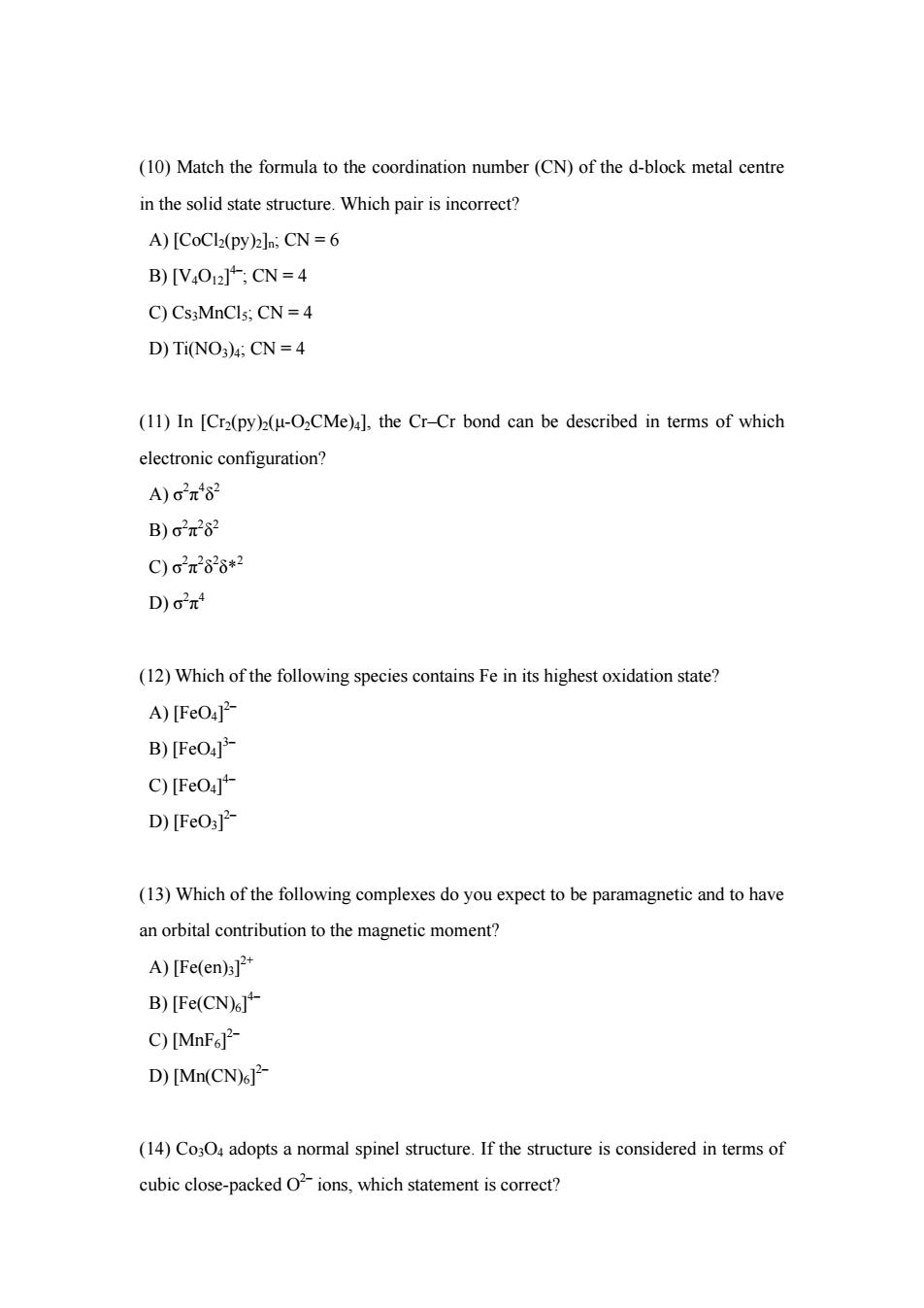
(10)Match the formula to the coordination number(CN)of the d-block metal centre in the solid state structure.Which pair is incorrect? A)[CoCl(py)]:CN=6 B)[V4O2],CN=4 C)Cs:MnCls;CN=4 D)Ti(NO3)4;CN=4 (11)In [Cr2(py)(H-OCMe)].the Cr-Cr bond can be described in terms of which electronic configuration? A)282 B)62x28 C)62x2828*2 D)62x (12)Which of the following species contains Fe in its highest oxidation state? A)[FeO B)FeO产 C)[FeO] D)[FeO3 (13)Which of the following complexes do you expect to be paramagnetic and to have an orbital contribution to the magnetic moment? A)[Fe(en)s B)[Fe(CN)] C)[MnFs]2- D)[Mn(CN)] (14)CoO adopts a normal spinel structure.If the structure is considered in terms of cubic close-packed-ions,which statement is correct?
(10) Match the formula to the coordination number (CN) of the d-block metal centre in the solid state structure. Which pair is incorrect? A) [CoCl2(py)2]n; CN = 6 B) [V4O12] 4–; CN = 4 C) Cs3MnCl5; CN = 4 D) Ti(NO3)4; CN = 4 (11) In [Cr2(py)2(μ-O2CMe)4], the Cr–Cr bond can be described in terms of which electronic configuration? A) σ 2 π 4 δ2 B) σ 2 π 2 δ2 C) σ 2 π 2 δ2 δ*2 D) σ 2 π 4 (12) Which of the following species contains Fe in its highest oxidation state? A) [FeO4] 2– B) [FeO4] 3– C) [FeO4] 4– D) [FeO3] 2– (13) Which of the following complexes do you expect to be paramagnetic and to have an orbital contribution to the magnetic moment? A) [Fe(en)3] 2+ B) [Fe(CN)6] 4– C) [MnF6] 2– D) [Mn(CN)6] 2– (14) Co3O4 adopts a normal spinel structure. If the structure is considered in terms of cubic close-packed O2– ions, which statement is correct? 3
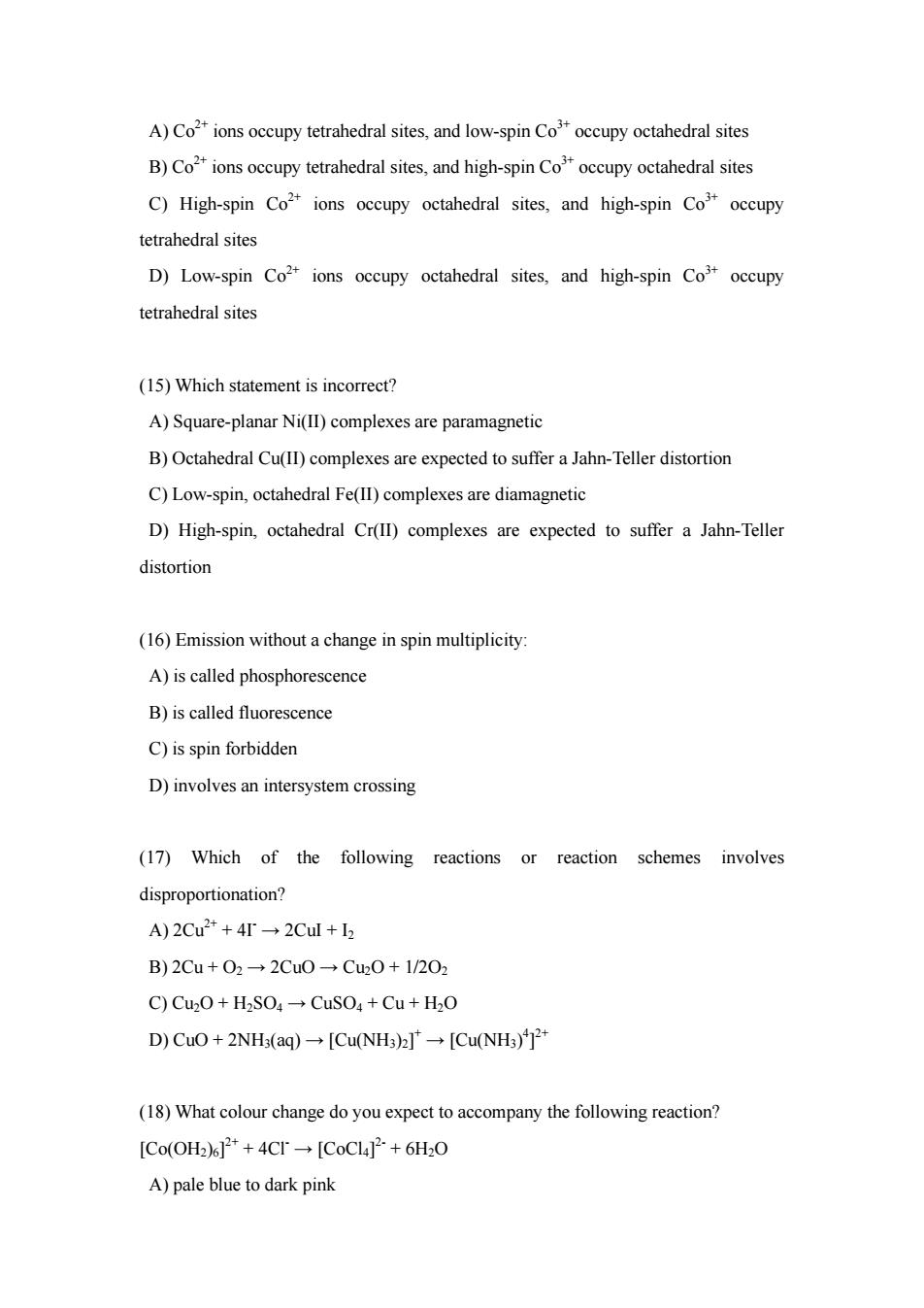
A)Coions occupy tetrahedral sites,and low-spin Cooccupy octahedral sites B)Coions occupy tetrahedral sites.and high-spin Cooccupy octahedral sites C)High-spin Co2 ions occupy octahedral sites,and high-spin Co*occupy tetrahedral sites D)Low-spin Co2+ions occupy octahedral sites,and high-spin Co occupy tetrahedral sites (15)Which statement is incorrect? A)Square-planar Ni(II)complexes are paramagnetic B)Octahedral Cu(I)complexes are expected to suffer a Jahn-Teller distortion C)Low-spin,octahedral Fe(II)complexes are diamagnetic D)High-spin,octahedral Cr(II)complexes are expected to suffer a Jahn-Teller distortion (16)Emission without a change in spin multiplicity: A)is called phosphorescence B)is called fluorescence C)is spin forbidden D)involves an intersystem crossing (17)Which of the following reactions or reaction schemes involves disproportionation? A)2Cu2++4→2Cul+2 B)2Cu+02→2Cu0→Cu20+1/202 C)Cu2O+H2SOa-CuSOa+Cu+H2O D)CuO+2NH(aq)→[CuNH2→[CuNH) (18)What colour change do you expect to accompany the following reaction? [Co(OH2)*+4Cr[CoCL]2+6H2O A)pale blue to dark pink
A) Co2+ ions occupy tetrahedral sites, and low-spin Co3+ occupy octahedral sites B) Co2+ ions occupy tetrahedral sites, and high-spin Co3+ occupy octahedral sites C) High-spin Co2+ ions occupy octahedral sites, and high-spin Co3+ occupy tetrahedral sites D) Low-spin Co2+ ions occupy octahedral sites, and high-spin Co3+ occupy tetrahedral sites (15) Which statement is incorrect? A) Square-planar Ni(II) complexes are paramagnetic B) Octahedral Cu(II) complexes are expected to suffer a Jahn-Teller distortion C) Low-spin, octahedral Fe(II) complexes are diamagnetic D) High-spin, octahedral Cr(II) complexes are expected to suffer a Jahn-Teller distortion (16) Emission without a change in spin multiplicity: A) is called phosphorescence B) is called fluorescence C) is spin forbidden D) involves an intersystem crossing (17) Which of the following reactions or reaction schemes involves disproportionation? A) 2Cu2+ + 4I- → 2CuI + I2 B) 2Cu + O2 → 2CuO → Cu2O + 1/2O2 C) Cu2O + H2SO4 → CuSO4 + Cu + H2O D) CuO + 2NH3(aq) → [Cu(NH3)2] + → [Cu(NH3) 4 ] 2+ (18) What colour change do you expect to accompany the following reaction? [Co(OH2)6] 2+ + 4Cl- → [CoCl4] 2- + 6H2O A) pale blue to dark pink 4
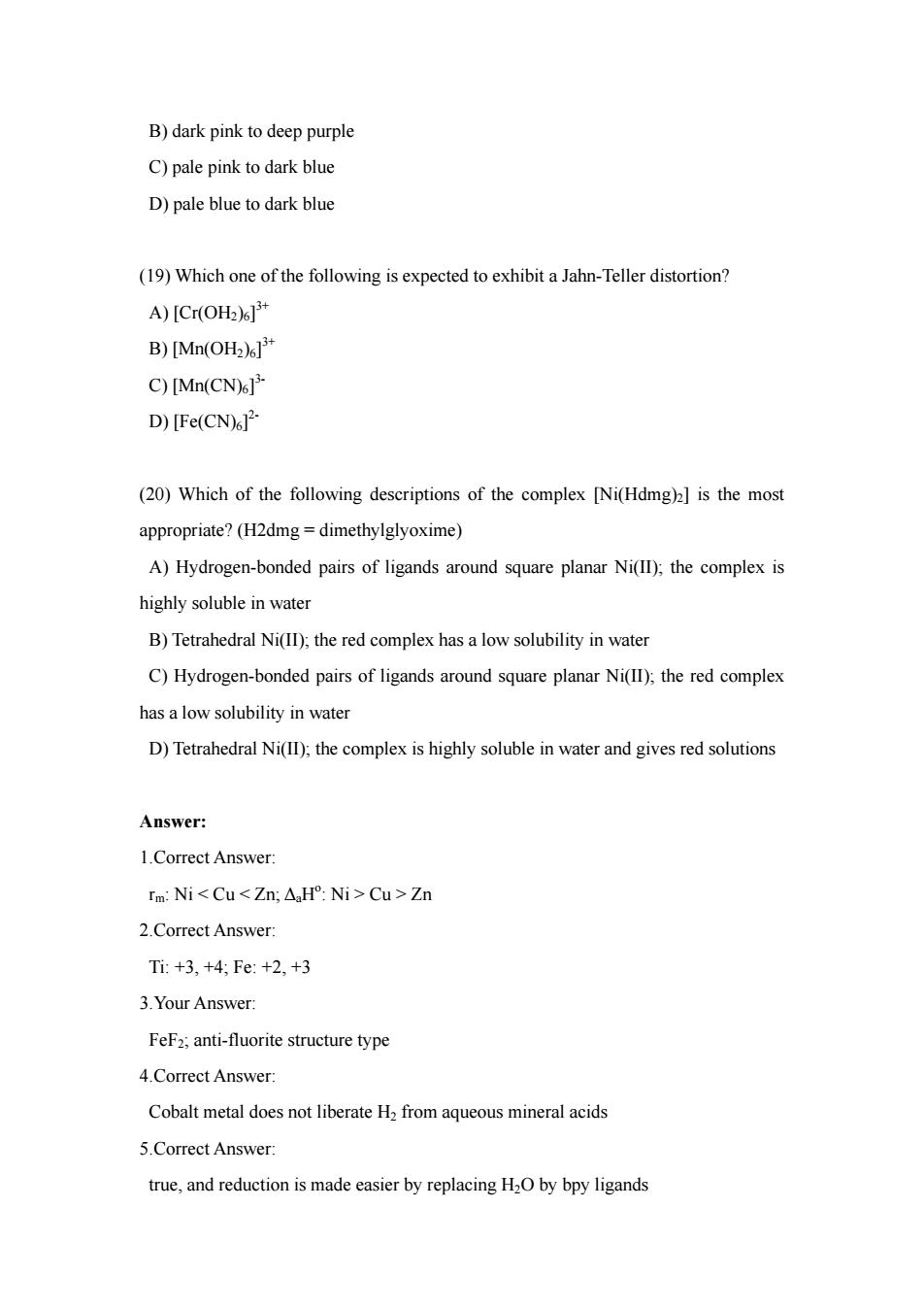
B)dark pink to deep purple C)pale pink to dark blue D)pale blue to dark blue (19)Which one of the following is expected to exhibit a Jahn-Teller distortion? A)[Cr(OH2)] B)[Mn(OH2)] C)[Mn(CN)] D)[Fe(CN) (20)Which of the following descriptions of the complex [Ni(Hdmg)]is the most appropriate?(H2dmg=dimethylglyoxime) A)Hydrogen-bonded pairs of ligands around square planar Ni(II);the complex is highly soluble in water B)Tetrahedral Ni(ID),the red complex has a low solubility in water C)Hydrogen-bonded pairs of ligands around square planar Ni(II);the red complex has a low solubility in water D)Tetrahedral Ni(l)the complex is highly soluble in water and gives red solutions Answer: 1.Correct Answer rmNi<Cu<Zm,△aH°:Ni>Cu>Zn 2.Correct Answer: Ti:+3,+4,Fe+2,+3 3.Your Answer: FeF2,anti-fluorite structure type 4.Correct Answer: Cobalt metal does not liberate H2 from aqueous mineral acids 5.Correct Answer true,and reduction is made easier by replacing HO by bpy ligands
B) dark pink to deep purple C) pale pink to dark blue D) pale blue to dark blue (19) Which one of the following is expected to exhibit a Jahn-Teller distortion? A) [Cr(OH2)6] 3+ B) [Mn(OH2)6] 3+ C) [Mn(CN)6] 3- D) [Fe(CN)6] 2- (20) Which of the following descriptions of the complex [Ni(Hdmg)2] is the most appropriate? (H2dmg = dimethylglyoxime) A) Hydrogen-bonded pairs of ligands around square planar Ni(II); the complex is highly soluble in water B) Tetrahedral Ni(II); the red complex has a low solubility in water C) Hydrogen-bonded pairs of ligands around square planar Ni(II); the red complex has a low solubility in water D) Tetrahedral Ni(II); the complex is highly soluble in water and gives red solutions Answer: 1.Correct Answer: rm: Ni < Cu < Zn; ΔaHo : Ni > Cu > Zn 2.Correct Answer: Ti: +3, +4; Fe: +2, +3 3.Your Answer: FeF2; anti-fluorite structure type 4.Correct Answer: Cobalt metal does not liberate H2 from aqueous mineral acids 5.Correct Answer: true, and reduction is made easier by replacing H2O by bpy ligands 5